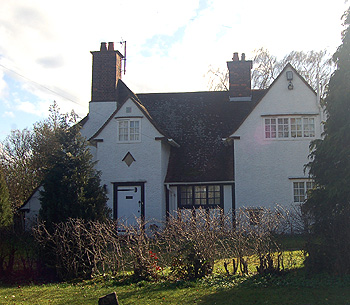White Cottage 17 Church End Biddenham

17 Church End March 2012
White Cottage was built by Arts and Crafts Movement architect Mackay Hugh Baillie-Scott (1865-1945) who also designed 9 Main Road. It was listed by the former Department of Environment in June 1972 as Grade II, of special interest. The house was built about 1910 in what the department calls "a simplified Tudor style". The Arts and Crafts Movement was all about returning to standards of craftsmanship often linked with medieval or early post-medieval type designs.
The house built of white painted rough-cast with a tiled roof. It comprises two storeys with gables. It has a two storey gabled porch. To the right is a one storey timber-framed part of the house. To the right of this is a gable with mullion windows on both floors. Certainly a quick glance might suggest a rendered Tudor house.
The Rating Valuation Act 1925 specified that every building and piece of land in the country was to be assessed to determine the rates to be paid on it. The valuer visiting 17 Church End [DV1/C123/85] found the property owned by a Mrs. Springle and occupied by a Miss Street, no rent was specified, merely the phrase "family rent".
The property stood in just over half an acre and comprised two reception rooms, a kitchen, a hall (“small”) and a W. C. downstairs, with three bedrooms, a dressing room, a bathroom and a W. C. upstairs. Outside stood a wood and tiled cycle shed and a coal barn. The valuer commented: “very awkward to measure". Water was laid on and the house had electric lighting. The valuer summed up: “Very nice place, good garden”. He also commented: “Very slopey”.
Directories for Bedfordshire were not published every year but every few years. Kelly's Directory for the county in 1914, 1920 and 1924 gives the occupiers as the Misses Street. This was dow to one Miss Street by 1928 and remained so in the last few Bedfordshire directories to be published, those of 1931, 1936 and 1940. Plans held by Bedfordshire and Luton Archives and Records Service show that extensions were planned in 1988 and 1989 [BorBTP/88/3102/LB and BorBTP/89/783/LB].